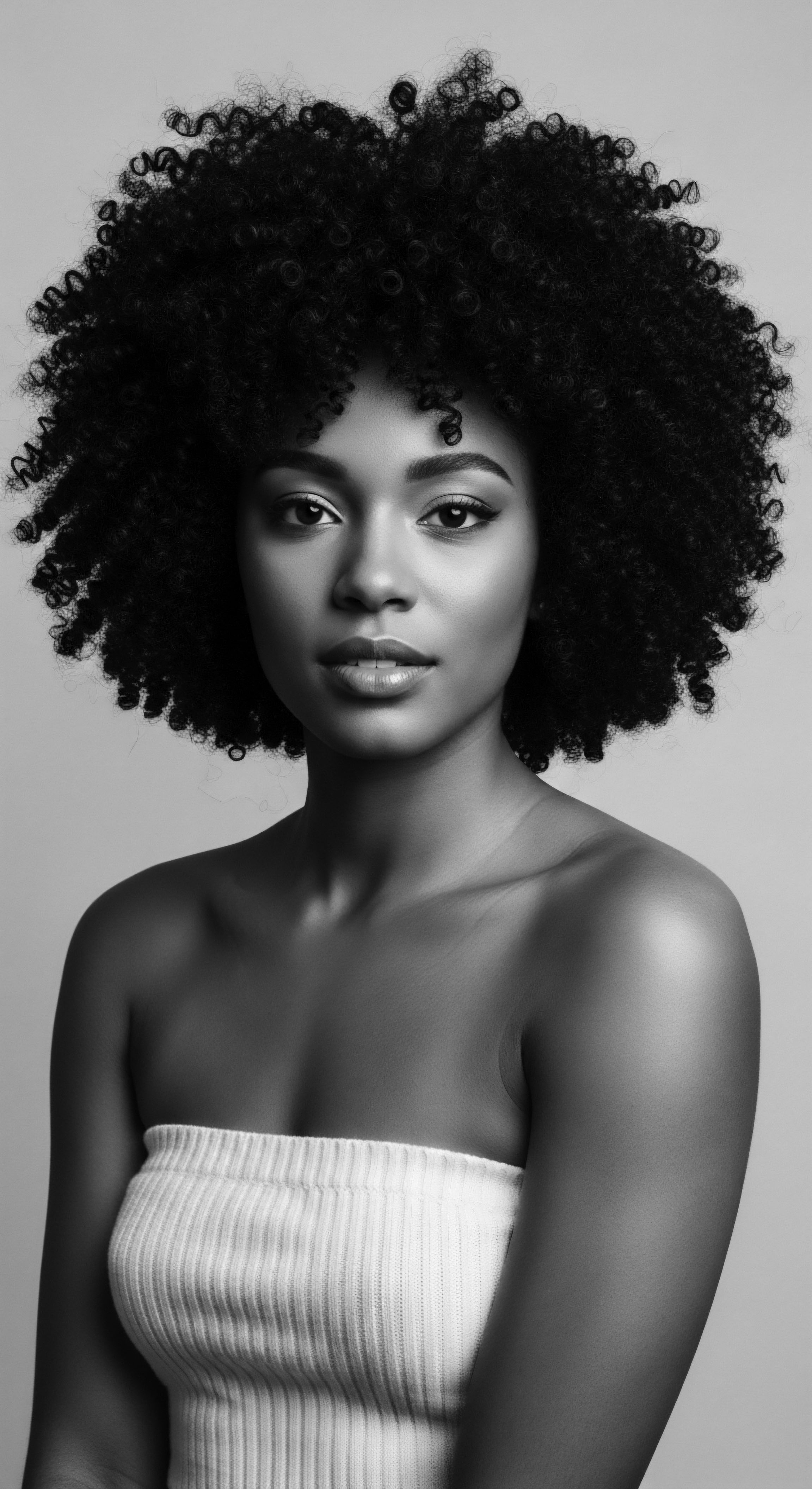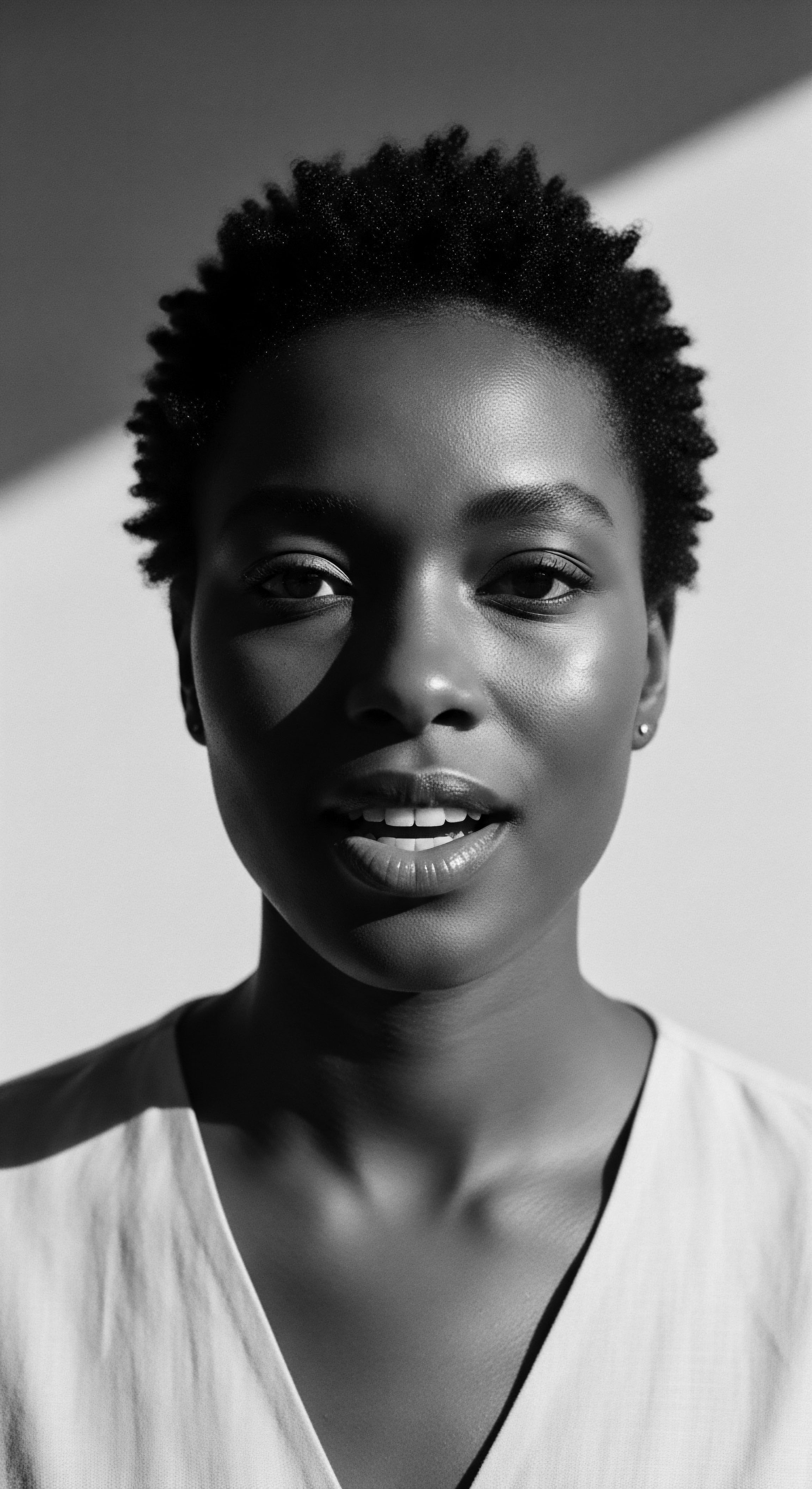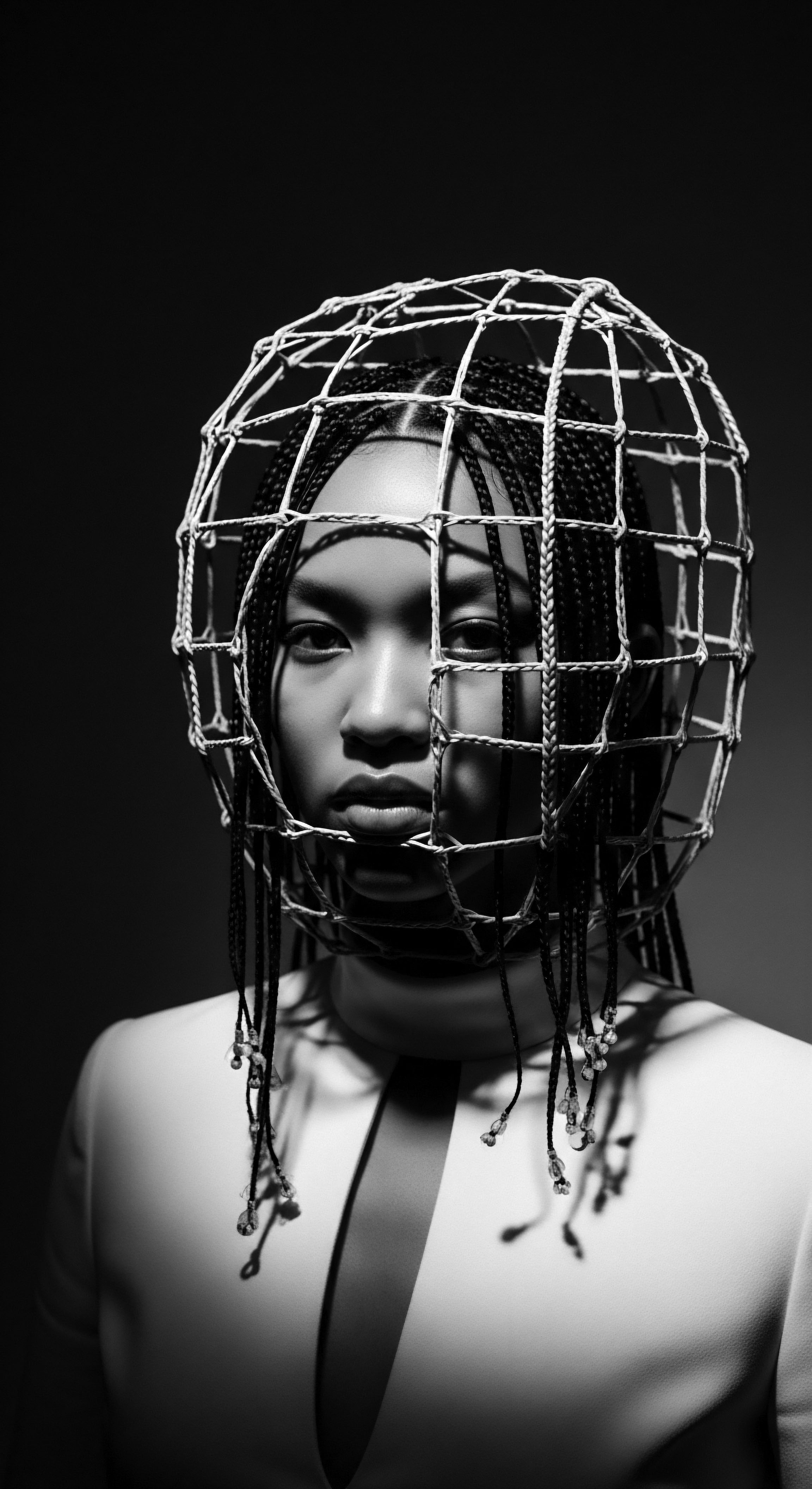
Roots
To truly understand the essence of raw shea butter’s relationship with textured hair, we must first listen to the echoes from ancestral lands, where the shea tree, Vitellaria paradoxa, has long been revered. This exploration is not simply about an ingredient; it is a communion with generations of wisdom, a recognition of how communities have nurtured and protected their strands through time, often with the very gifts of the earth. We are not merely inquiring into a botanical’s function; we are stepping into a lineage of care, where the vitality of hair was often intertwined with personal identity and communal well-being.
The anatomy of textured hair, with its unique coil patterns and elliptical cross-sections, presents a distinct set of considerations for moisture preservation. Unlike straighter hair types, the twists and turns of a textured strand create natural points where the cuticle, the outermost layer of the hair, can be raised. This architectural difference means that moisture, so vital for strength and flexibility, can escape more readily.
Ancient caretakers of hair, though without the lexicon of modern trichology, intuitively understood this susceptibility to dryness. Their practices were not born of scientific treatises but from observation, trial, and the deep, communal sharing of wisdom that spans centuries.
Consider the historical understanding of how hair maintained its supple quality. In West Africa, where the shea tree flourishes, the daily rhythms of life brought people into constant interaction with their environment. The sun, the wind, the dust—these elements posed a constant challenge to hair integrity.
What emerged were preventative rituals, often involving the application of natural butters and oils, long before the term ‘occlusive’ entered our vocabulary. These preparations, often passed down through matriarchal lines, served a fundamental purpose ❉ to create a protective embrace for the hair, shielding it from external aggressors and helping to maintain its inherent moisture.
The enduring connection between raw shea butter and textured hair care finds its origins in ancestral understanding of hair’s delicate nature and the earth’s protective offerings.
Raw shea butter, extracted through time-honored artisanal methods, carries a rich history. Archaeological excavations at Kirikongo in western Burkina Faso, led by anthropologist Daphne Gallagher, have presented compelling evidence of shea butter production dating back to at least A.D. 100 (Gallagher et al. 2016).
This remarkable finding speaks to the antiquity of this resource, demonstrating its profound and continuous importance within early agricultural diets and, by extension, traditional cosmetic practices for over 1,900 years. The very process of preparing shea butter, often a communal endeavor primarily undertaken by women, itself embodies a continuity of heritage. Nuts are hand-harvested, dried, crushed, and then boiled, allowing the precious butter to separate and solidify—a process rooted in deep respect for the ingredient and the hands that prepare it. This butter became a staple, not just for nourishing the body, but for tending to the crown, symbolizing vitality and protection within many communities.
The term ‘sealing’ in modern hair science refers to applying a lipid-rich substance to the hair shaft to reduce moisture loss. While ancestral practices may not have used this precise scientific term, the effect of their applications often mirrored this principle. They recognized that once hair was hydrated—often with water or water-infused botanical concoctions—a barrier was needed to hold that life-giving dampness within the strand.
Raw shea butter, with its fatty acid profile, naturally forms a protective layer, lending itself to this ancestral goal. Its composition, rich in stearic and oleic acids, provides a tangible embrace for the hair, helping to keep it pliable and resilient.
Understanding this foundational relationship requires us to look beyond mere function and perceive the deeper meaning embedded in the butter itself. It is a symbol of sustenance, of shared labor, and of an ancestral covenant with the natural world.
- Traditional Water-Based Preparations ❉ Many African hair traditions began with water, often infused with herbs or plant extracts, to hydrate the hair. This foundational step set the stage for subsequent applications.
- Application of Plant Butters and Oils ❉ Following hydration, substances like shea butter or various plant oils were applied. These served as rich emollients, forming a physical barrier on the hair surface.
- Protective Styling Integration ❉ After conditioning and butter application, hair was frequently styled into braids, twists, or threading techniques. These styles further protected the hair, reducing exposure to the elements and maintaining the benefits of the applied butters.

Ritual
From the very moment raw shea butter was drawn from the earth, it entered the realm of ritual, a transformative space where care became art, and application became an act of reverence for the textured strand. The question of whether raw shea butter ‘seals’ textured hair transcends a simple yes or no; it delves into the historical context of its application, the cultural significance of hair adornment, and the ingenious methods by which ancestral communities maximized its inherent properties. For them, the butter was not merely a cosmetic; it was a partner in shaping identity, a tool in the hands of tradition bearers.
The journey of shea butter from tree to hair is a testament to persistent human ingenuity and a profound connection to the natural world. In myriad West African communities, the preparation of hair often began with cleansing and conditioning, followed by the careful application of emollients like shea butter. This was frequently part of a broader, more deliberate process to prepare the hair for intricate styles that served not only aesthetic purposes but also protective functions.
Imagine the hands of an elder, patiently working a small amount of the ivory butter into the hair of a child, their actions imbued with generations of transmitted knowledge. This was not about a quick fix but about a deep, sustained commitment to the health and presentation of the hair.

How Did Ancestral Practices Harness Shea Butter?
Ancestral hair care rituals, long preceding modern classifications, often revolved around the principle of nurturing hair from within and shielding it from external elements. Shea butter was an essential component in this holistic approach. Its richness provided a dense, protective coating, effectively helping to hold in moisture previously introduced through water-based treatments or conditioning agents.
This was particularly pertinent for textured hair, which, as discussed, is more prone to moisture evaporation due to its structural characteristics. The practice was less about an immediate ‘seal’ in the contemporary sense of an impermeable layer, and more about creating a sustained environment of moisture retention and protection.
The use of shea butter in historical hair care rituals was an intentional act of preservation, aiming to protect and maintain hair moisture through a combination of traditional wisdom and styling techniques.
The application often accompanied styling practices, particularly protective styles. The women of Chad, for instance, are noted for their use of the Chebe powder tradition, which involves mixing it with moisturizing substances like shea butter. This mixture is then applied to hydrated hair, which is subsequently braided to lock in moisture and protect the hair.
This exemplifies a historical practice where the butter and styling technique worked in concert to achieve moisture retention and length preservation. The butter softened the hair, making it more pliable for braiding, while the braids themselves minimized manipulation and exposure, thereby extending the effectiveness of the applied butter.
Beyond the protective function, raw shea butter was also employed for its conditioning properties, softening hair and imparting a healthy sheen. In some communities, it served as a traditional pomade, helping to hold styles and gently ease curls, enhancing the appearance of the hair while simultaneously caring for it. The cultural context of these applications is vital; hair was often a canvas for social status, age, marital standing, or tribal affiliation. The health and appearance of hair, therefore, were not trivial matters but deeply embedded in personal and communal identity.
| Ancestral Practice Post-Hydration Coating |
| Contemporary Understanding of Action Forms a lipid barrier, minimizing water evaporation from the hair shaft. |
| Heritage Context A practical response to environmental dryness in various African regions. |
| Ancestral Practice Styling Pomade |
| Contemporary Understanding of Action Provides hold and pliability for shaping hair, reducing frizz. |
| Heritage Context Facilitated intricate protective styles like braids and twists for adornment and protection. |
| Ancestral Practice Scalp Massage Medium |
| Contemporary Understanding of Action Conditions the scalp, alleviates dryness, and promotes overall scalp health. |
| Heritage Context Part of holistic wellness, recognizing the scalp as the foundation for healthy hair growth. |
| Ancestral Practice These traditional applications of raw shea butter demonstrate a continuity of care that bridges ancient wisdom with modern hair science, always valuing the strand's vitality. |
The continuous use of shea butter in such profound ways across different African cultures attests to its efficacy and adaptability. It signifies a wisdom that prioritized the strand’s intrinsic needs, recognizing that a well-cared-for coil or kink was a reflection of attentiveness and cultural continuity. The rituals surrounding shea butter were, and remain, acts of self-care and community bonding, deeply woven into the fabric of daily life.

What is the Cultural Resonance of Shea Butter in Hair Artistry?
The cultural resonance of shea butter in hair artistry reaches far beyond its chemical composition. It is intrinsically tied to the collective memory of communal gathering for hair braiding, the quiet moments of intergenerational knowledge transfer, and the celebratory adornment of self and others. Hair, in many African societies, served as a powerful medium for conveying status, identity, and personal narrative. The care products, including shea butter, were not mere adjuncts but participants in this deeper cultural dialogue.
This butter played a role in maintaining the integrity of hair that was meticulously styled for ceremonies, rites of passage, or everyday life. Styles like cornrows, which can be traced back to 3000 BCE, were not just aesthetic choices but practical, protective measures designed to preserve length and minimize damage. Shea butter, when applied to hair before or during the creation of these styles, would have contributed to their longevity and the overall health of the hair underneath, acting as a buffer against environmental factors and daily friction. The very act of preparing and applying the butter, often a shared endeavor, also served to strengthen community bonds and reinforce cultural values related to self-presentation and collective identity.

Relay
To truly grasp whether raw shea butter ‘seals’ textured hair, we must bring the clarity of scientific understanding into conversation with the enduring wisdom of ancestral practices. The question is not merely about a physical barrier but about a complex interplay of hair biology, ingredient properties, and the nuanced intention of care. From a scientific viewpoint, ‘sealing’ involves creating an occlusive layer that minimizes transepidermal water loss from the hair shaft. Raw shea butter, with its distinct chemical makeup, certainly possesses properties that contribute significantly to this effect.
Raw shea butter consists primarily of fatty acids, notably stearic acid (typically 25-50%) and oleic acid (40-60%), alongside smaller amounts of linoleic, palmitic, and arachidic acids. This particular blend of saturated and monounsaturated fatty acids gives shea butter its solid consistency at room temperature and its ability to melt at body temperature, allowing it to spread readily over hair strands. When applied, these fatty acids arrange themselves to form a hydrophobic, or water-repelling, film around the hair shaft. This film acts as a physical barrier, effectively reducing the rate at which water evaporates from the hair’s surface.

How Does Raw Shea Butter Create a Protective Layer?
The term ‘seal’ might suggest an absolute, impenetrable barrier, which is rarely the case with any natural hair product. Instead, raw shea butter creates a semi-occlusive layer. Imagine it not as an airtight lid but as a protective wrap that slows down moisture escape, allowing the hair to retain hydration for longer periods.
This is particularly beneficial for textured hair, which, due to its unique cuticle structure—often lifted at the curves of the coil—can lose moisture more rapidly than straight hair types. By providing a substantial lipid layer, shea butter helps flatten and smooth these cuticles, reducing moisture pathways.
Beyond its occlusive capabilities, shea butter also brings a host of other benefits that contribute to overall hair health, stemming from its rich composition. It contains unsaponifiable components, including vitamins A, E, and F, as well as triterpenes and phytosterols. These compounds contribute to its emollient properties, helping to soften and condition the hair. They also possess antioxidant qualities, which can offer some protection against environmental stressors, and anti-inflammatory attributes that may soothe a dry or irritated scalp.
The traditional understanding of shea butter’s role was perhaps more holistic than our current segmented scientific terms. They understood it as a vital element for keeping hair supple, protected, and healthy. Whether they called it ‘sealing’ or simply ‘keeping the hair well,’ the outcome was consistent ❉ enhanced moisture retention and improved hair resilience, which aligns perfectly with modern scientific observations of its occlusive and emollient effects. The centuries of practical application stand as a testament to its efficacy, a living laboratory validating what science now explains.
Raw shea butter functions as a semi-occlusive agent for textured hair, forming a lipid film that helps to slow moisture evaporation and contributes to overall hair health through its rich vitamin and fatty acid content.
When considering the effective use of raw shea butter for moisture retention, the method of application remains paramount, echoing ancient wisdom. It is most effective when applied to hair that has already been hydrated with water or a water-based conditioner. The water provides the moisture, and the shea butter then helps to encapsulate it within the hair strand. This layering approach, often referred to as the ‘Liquid, Oil, Cream’ (LOC) method or similar iterations in contemporary hair care, finds its conceptual roots in these traditional practices of preparing hair with moisture before applying a richer, protective element.
The legacy of raw shea butter for textured hair care is therefore a beautiful relay ❉ ancient wisdom passed down through generations, continuously validated by the lived experiences of communities, and now, illuminated and deepened by the precise lens of scientific inquiry. It speaks to a shared human desire for wellness, an understanding that the earth offers remedies, and a persistent dedication to the care of one’s distinctive crown.
- Fatty Acid Profile ❉ Shea butter’s high content of stearic and oleic acids allows it to create a substantive, yet breathable, layer around the hair.
- Moisture Barrier Formation ❉ When applied to damp hair, it forms a hydrophobic film, reducing the rate of water escaping the hair shaft.
- Cuticle Smoothing Action ❉ The emollient properties help to lay down the hair’s cuticles, which can be raised in textured hair, further aiding in moisture retention.

Reflection
As we draw this meditation on raw shea butter and its relationship with textured hair to a close, a profound understanding emerges ❉ the answers we seek are not merely found in isolated scientific facts, but in the enduring continuity of heritage. The question, ‘Does raw shea butter seal textured hair?’ unwraps layers of ancestral wisdom, scientific observation, and the lived experiences of countless individuals across generations. It reveals a truth far richer than a simple yes or no.
Raw shea butter, a gift from the African savanna, has journeyed through time, its very existence intertwined with the resilience and creative spirit of Black and mixed-race communities. It has been a silent partner in the rhythms of daily care, a witness to the beauty and strength of hair that defies easy categorization. Its function as a ‘sealant’ in modern terms echoes the ancient intent of protection, of providing a comforting embrace for the hair, allowing it to retain the life-giving moisture that nourishes its intricate coils and patterns.
The ‘Soul of a Strand’ ethos reminds us that hair is more than just protein; it is a repository of stories, a canvas of identity, and a living connection to those who came before us. The use of raw shea butter is a tangible expression of this connection, a continuation of rituals that honor the unique needs of textured hair while affirming a powerful cultural legacy. In every application, there is a whisper of ancestral hands, a celebration of resilience, and a quiet affirmation of beauty.
This exploration, therefore, becomes a part of that living, breathing archive of textured hair. It is a testament to the ingenuity of traditional practices, the validating lens of contemporary science, and the holistic vision of wellness that recognizes hair care as an integral aspect of self-care and cultural affirmation. The story of raw shea butter and textured hair is a vibrant, continuous narrative—a reminder that the most profound insights often lie where heritage and understanding intertwine.

References
- Gallagher, D. D’Andrea, A. C. & Brass, M. (2016). The Archaeology of Shea Butter ❉ Documentation of Production and Use in Kirikongo, Burkina Faso. Journal of Ethnobiology, 36(1), 183-200.
- Abbiw, D. K. (1990). Useful Plants of Ghana ❉ West African Uses of Wild and Cultivated Plants. Intermediate Technology Publications.
- Goreja, W. G. (2004). Shea Butter ❉ The Nourishing Properties of Africa’s Best-Kept Natural Beauty Secret. TNC International.
- Maranz, S. & Wiesman, Z. (2003). Shea Butter Handbook. Shea Butter Institute.
- Kerharo, J. (1974). La Pharmacopée Sénégalaise Traditionnelle ❉ Plantes Médicinales et Toxiques. Vigot Frères.
- Falconi, C. (2009). The Science of Skin Care ❉ A Practical Guide to the Properties and Formulations of Cosmetic Products. Wiley-VCH.
- Diop, A. (2012). African Traditional Medicine. Africa World Press.
- Lamien, N. Maiga, M. & Diallo, D. (1996). The importance of Shea (Vitellaria paradoxa Gaertn. f.) in the rural economy of Burkina Faso. Agroforestry Systems, 33(1), 89-102.
